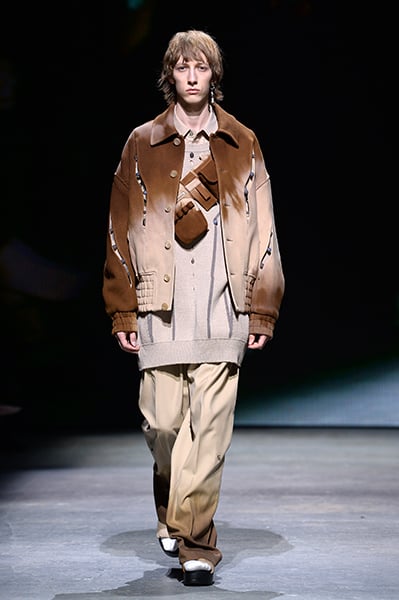Missed the 2020 International Woolmark Prize? Come backstage with us as we present all the looks direct from the runway.
A-COLD-WALL*
For the International Woolmark Prize, A-COLD-WALL* has researched the industrial techniques and uniforms encountered at various stages of the wool manufacturing process. Analysing workers garments and the organic transformations of fabric, A-COLD-WALL* has created a collection of ergonomic, elevated and functional wool clothing.
The project is divided into three elements, each containing two looks that represent and illustrate the narrative of a woollen garment.
The initial element of the project begins with ‘sheep shearers’, embodying the tactile, manual process they carry out to obtain a raw material and signify the beginning of any wool product. The second element to the project explores the transformative space of the ‘dye house’, with a particular focus on the physically demanding roles that constitute it. The final element examines the ‘eaver’ and the meticulous craft and complex artisanal skills associated with weaving fabric.
Blindness
Blindness draws inspiration from an issue they believe can no longer be ignored: pollution. Dubbed the plastic paradox, Blindness makes us consider the notion that plastic is eternity, yet plastic is disposable.
Military-like silhouettes and the genderless style of Blindness was expressed with inspiration from the navy who guard the sea, and so their collection tells the story of the navy that patrols over the marine environment.
Using the process of natural fermentation, Blindness was able to take the indigo dyeing pigment from the plant and successfully dye the wool fibre. Fishing net structures are reimagined in wool, and synthetic finishes and processes, such as plastic buttons and chemical dyes, are replaced with natural alternatives
BODE
Drawing inspiration from the developmental years of artist Benjamin Bloomstein, BODE explores the relationship between alternative education, agricultural communities and sustainability.
BODE’s focus is to educate and preserve history through craft and storytelling, telling the narratives of historic designs and patterns whilst using contemporary, sustainable and domestic manufacturing.
BODE aims to be a zero-waste label and is putting measures in place to achieve this. This includes archiving all fabrics and finding comprehensive use for fabric scraps, utilising advancements such as heat press as a form of appliqué and transfer and work with in-house manufactures on a larger scale.
The label's International Woolmark Prize collection comprises suiting and outerwear composed of reclaimed and equine show blankets and individually crocheted Merino wool fleurettes.
Botter
Upcycling and the adoption of DIY practices are at the heart of the Botter's collection, in which raw materials are highlighted rather than hidden and couture shapes emerge from traditionally classical silhouettes.
They twist couture shapes, creating unexpected coats with fitted fronts and balloon backs; reveal the hidden by turning a puffer jacket upside down; highlight raw materials with sophisticated hand techniques in wool wadding flower patterns, deadstock plastic tag pearl embroideries or fragile cracked silver foil embellishments; and recycle fabric stocks and wool blends. In other words, they strive to give life to the garment, questioning the notions of good taste and short-lived.
With an emphasis on natural beauty, Botter uses wool in unexpected ways, turning a coat inside out with natural wool wadding on the garment's exterior.
Feng Chen Wang
Designer Feng Chen Wang draws inspiration from traditional Chinese medicine in her Woolmark Prize collection to show how garments can contribute to wellbeing and mindfulness. From the use of natural dyes over chemical to the inclusion jade and agate embellishments that follow the map of the meridian system, this is wool as wellness.
Functional yet conceptual, Feng Chen Wang’s International Woolmark Prize collection was created with a sense of harmony and hope in mind, both with the natural world and the human body.
GmbH
Brutalist silhouettes and ambitious environmental policy goals of fabrics being organic, recycled, upcycled or biodegradable have quickly put German label GmbH on the global fashion map. In their Woolmark Prize collection, the designers explored plastic-free technical outerwear and digital printing with outstanding results. The swapping of wool for traditional fur in its knit dresses means that GmbH stays true to its environmentally conscious ethos.
For the International Woolmark Prize, GmbH embarked on a journey back to the origin of everything, with a collection called ‘Ylem’ “after the epoch that came shortly after the birth of our universe where all matter was created,” explain the designers.
Ludovic de Saint Sernin
Made in France is ethos of Ludovic de Saint Sernin, who sources and manufacturers locally to minimise his environmental footprint. Extrafine Merino Wool layers are contrasted by rich, oversized outerwear in his Woolmark Prize collection.
For the International Woolmark Prize, Ludovic de Saint Sernin presents ‘Heartbreak’, a cathartic expression inspired by experiencing a break-up of his own last year. A broken heart symbol appears throughout the collection, yet through break up comes both fragility and strength. We see extrafine wool semi-transparent bodies, juxtaposed with robust and comforting wool coats. The eyelet brief - which quickly became a signature of the brand - also makes an appearance, this time reimagined in wool.
Matthew Adams Dolan
Matthew Adams Dolan explores the weather-proof and water-resistant properties of wool in his Woolmark Prize collection, with luxuriously double-faced fabrics and high-tech yarns making up his nautical-inspired, effortlessly tailored garments.
Adams Dolan explores the legacies of America’s maritime history; silhouettes, textiles and graphic ideas are at once taken from traditions of foul weather gear and wool’s seafaring past along with its inherent water repellent and thermoregulating properties provide inspiration for the collection.
Namacheko
The designers behind Namacheko have taken inspiration from the lifecycle of wool for their Woolmark Prize collection, developing knitting and fabric structures that tell the story from yarn creation to its end-of-life. Inspired by Gregory Crewdson, with whom they collaborated.
Namacheko has taken inspiration from the full lifecycle of wool - from yarn creation to its use phase and after life - to develop knitting and fabric structures throughout the collection in every look and piece. From spinning and combing yarns to twisting the fibres they are all reflected in the textures and fabric developments.
Richard Malone
Richard Malone created a collection inspired by his upbringing in Wexford to create considered, functional and beautifully made garments that minimise harm to our environment and works towards creating a circular, sustainable fashion system.
Eliminating traditional chemicals to provide a natural, less intensive method of dyeing, the Irish designer worked with a society of incredibly skilled weavers in Tamil Nadu, India, using completely organic and plant-based dyes as well as more recent innovations using Merino wool and other conscious fibres.































